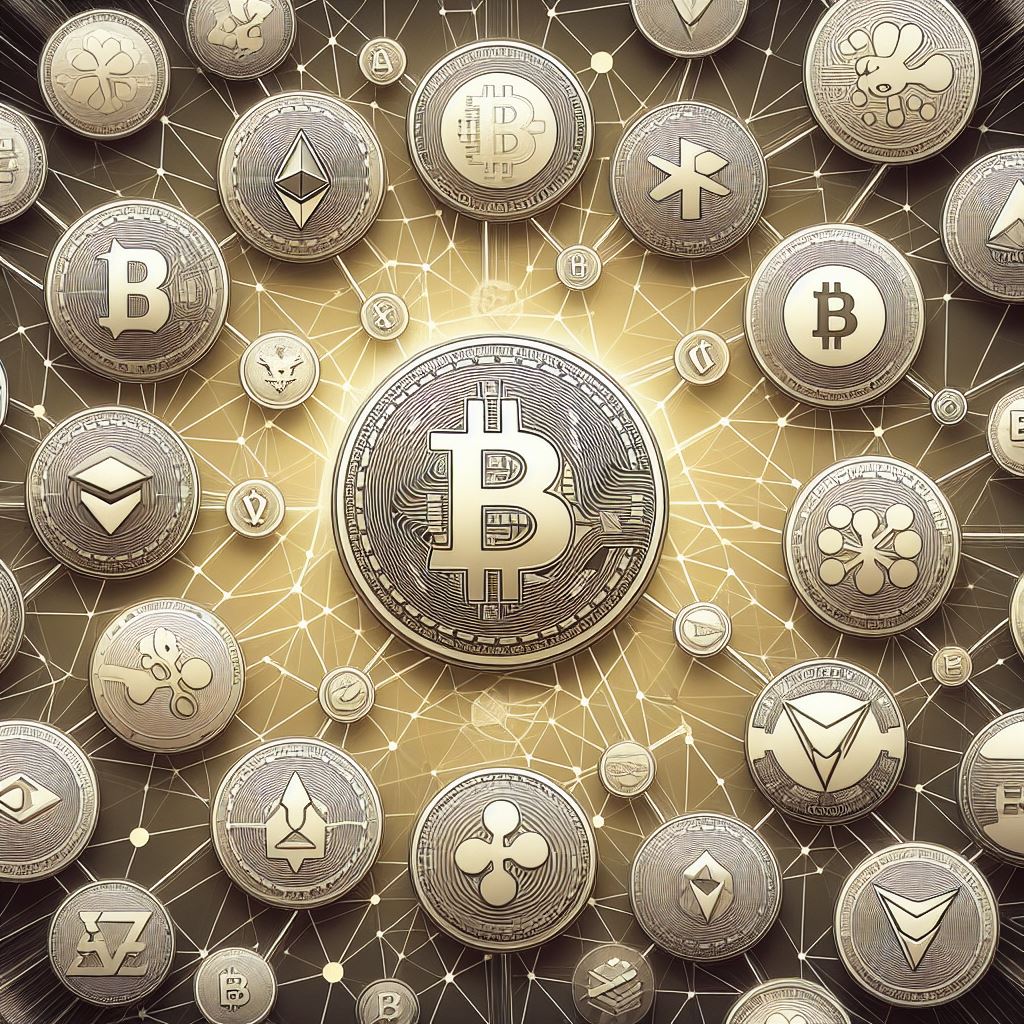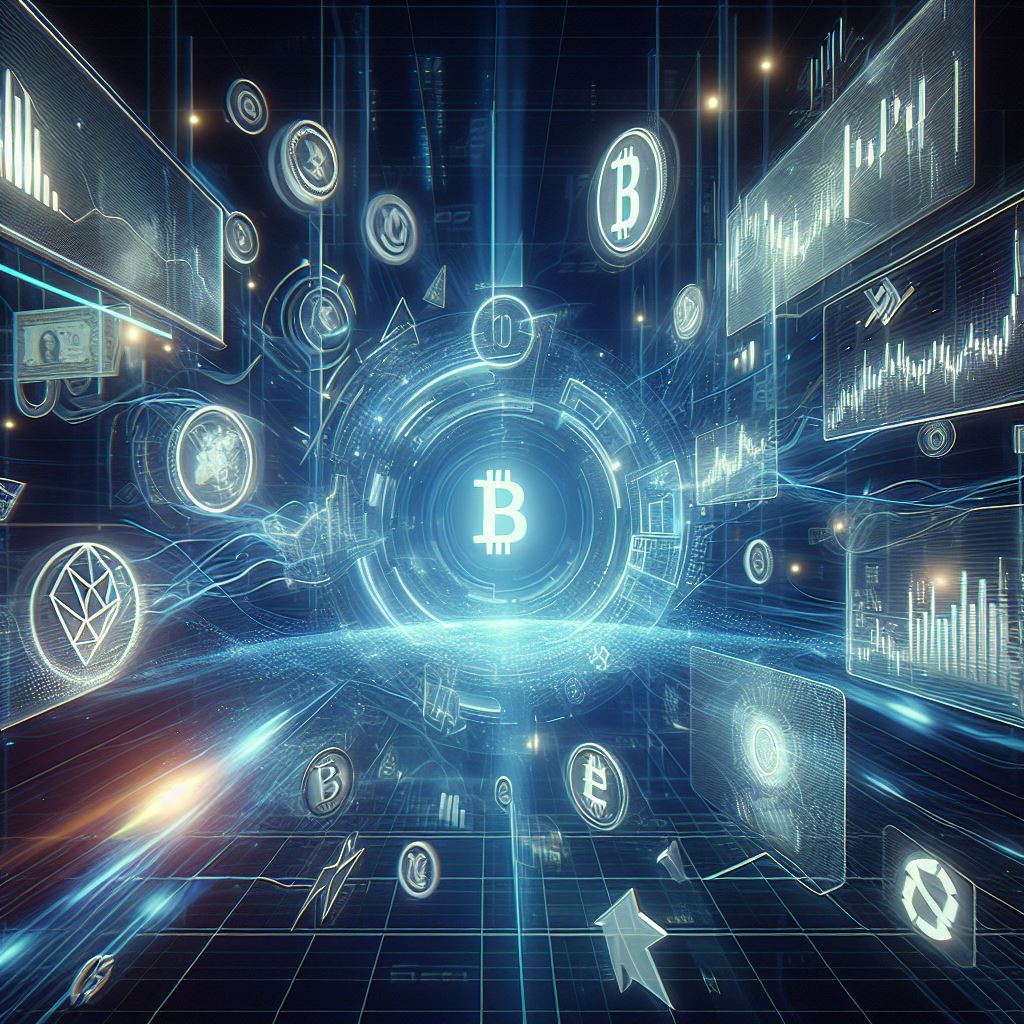Key Takeaways:
- Altcoins encompass all cryptocurrencies other than Bitcoin, introducing new technologies, use cases, and models.
- Major altcoin categories include smart contract platforms, privacy coins, stablecoins, meme coins, and more.
- Top altcoin projects in 2023 include Ethereum, Litecoin, Ripple, Cardano, Solana, and many others.
- Altcoins drive innovation, enable scalability solutions, facilitate new decentralized applications, and provide portfolio diversification opportunities.
- Evaluating factors like technology, team, adoption, and tokenomics is crucial before investing in altcoin projects.
I. Introduction to Altcoins
A. Definition and Origins The term “altcoin” is a portmanteau of “alternative” and “coin,” referring to any cryptocurrency that emerged as an alternative to Bitcoin, the pioneering digital asset. Altcoins leverage blockchain technology but introduce distinct features, consensus mechanisms, and use cases beyond Bitcoin’s original design as a decentralized peer-to-peer electronic cash system.
B. The Rise of Altcoins While Bitcoin paved the way for blockchain and cryptocurrency adoption, the open-source nature of its underlying technology sparked a wave of innovation and experimentation. Developers and entrepreneurs began creating new cryptocurrencies, each with unique value propositions, to address perceived limitations or explore novel applications of blockchain.
The first altcoin, Namecoin, was launched in 2011, followed by a surge in altcoin development, including notable projects like Litecoin, Ripple, and Ethereum in subsequent years. Today, the altcoin ecosystem has flourished, with thousands of cryptocurrencies vying for attention and adoption across various sectors.
C. Distinction from Bitcoin Unlike Bitcoin, which primarily functions as a decentralized digital currency and store of value, altcoins often introduce advanced features and capabilities beyond simple peer-to-peer transactions. These innovations include smart contract functionality, privacy-preserving protocols, alternative consensus mechanisms, and tokenized representations of assets or utilities within decentralized ecosystems.
While Bitcoin maintains its position as the preeminent cryptocurrency, altcoins collectively represent the dynamism and diversity of the broader crypto landscape, pushing the boundaries of blockchain technology and enabling new use cases across industries.
II. Categories of Altcoins
The altcoin ecosystem comprises a diverse array of cryptocurrencies designed for various purposes and applications. Here are some of the primary categories:
A. Smart Contract Platforms Smart contract platforms like Ethereum, Cardano, and Solana enable the development and execution of decentralized applications (dApps) and self-executing contracts on their respective blockchains. These altcoins serve as the foundational layer for the flourishing decentralized finance (DeFi) ecosystem, enabling programmable digital agreements, tokenization of assets, and a wide range of web3 applications.
B. Privacy Coins Cryptocurrencies such as Monero, Zcash, and Dash prioritize transaction privacy and anonymity through advanced cryptographic techniques and privacy-preserving protocols. These altcoins obfuscate transaction details, shielding user identities and financial data from prying eyes, catering to individuals and entities seeking enhanced financial privacy.
C. Stablecoins Stablecoins like Tether (USDT), USD Coin (USDC), and Dai aim to maintain price stability by pegging their value to stable reserve assets such as the U.S. dollar or other fiat currencies. These altcoins facilitate trading, lending, and transactions within the volatile crypto ecosystem while minimizing the risks associated with price fluctuations.
D. Meme Coins Initially launched as internet jokes or parodies, meme coins like Dogecoin and Shiba Inu have garnered significant attention and market value, driven by community sentiment, speculative trading, and influential endorsements. While lacking substantial utility, their cultural phenomenon status and devoted followings contribute to their longevity and market presence.
E. Other Altcoin Types Beyond the main categories mentioned above, the altcoin landscape encompasses various other types, including:
- Platform Tokens: Native cryptocurrencies of specific blockchain platforms like EOS, Tron, and Waves.
- Security Tokens: Tokenized representations of traditional assets like stocks, real estate, and commodities.
- Utility Tokens: Cryptocurrencies powering specific applications or ecosystems, such as Basic Attention Token (BAT) for the Brave browser.
- NFT Tokens: Cryptocurrencies focused on non-fungible token (NFT) marketplaces and ecosystems, enabling the trade and ownership of digital collectibles.
As blockchain technology continues to evolve, new innovative altcoin projects emerge, catering to diverse needs and industries, further expanding the boundaries of decentralized applications and disrupting traditional business models.
III. Benefits and Use Cases of Altcoins
While Bitcoin remains the flagship cryptocurrency, altcoins offer several potential advantages and use cases that drive their growth and adoption:
A. Technological Innovation Many altcoins introduce cutting-edge blockchain innovations, such as sharding, layer 2 scaling solutions, advanced smart contract capabilities, and novel consensus mechanisms. These technological advancements push the boundaries of decentralized applications (dApps) and enable new possibilities across various sectors, from finance and supply chain management to gaming and identity management.
B. Scalability Solutions Scalability has been a persistent challenge for major blockchains like Bitcoin and Ethereum, limiting their ability to handle high transaction volumes efficiently. Altcoins like Solana, Avalanche, and Polygon explore novel scaling approaches through high throughput, low fees, and enhanced performance, aiming to meet the growing demands of decentralized applications and user adoption.
C. Decentralized Applications (dApps) Altcoins facilitate the creation of decentralized ecosystems tailored for various applications, such as decentralized finance (DeFi), supply chain management, gaming, identity management, and more. These decentralized applications (dApps) disrupt traditional centralized models by offering enhanced transparency, security, and user control, unlocking new use cases and reshaping industries.
D. Portfolio Diversification Investing in a diverse range of promising altcoins alongside Bitcoin can potentially diversify one’s crypto portfolio and mitigate risks associated with holding a single asset. Diversification allows investors to capitalize on different growth opportunities and hedge against market volatility within the rapidly evolving cryptocurrency landscape.
E. Potential for High Returns While inherently volatile and risky, altcoins offer the potential for substantial price appreciation and returns if successful projects gain significant traction and adoption. This high-risk, high-reward profile attracts speculative investors seeking outsized returns, albeit with the caveat of thorough due diligence and risk management.
By exploring innovative blockchain solutions, altcoins collectively drive the broader cryptocurrency ecosystem forward, enabling enhanced functionality, scalability, and real-world utility beyond Bitcoin’s core purpose as a digital store of value and medium of exchange.
IV. Risks and Challenges Surrounding Altcoins
Despite their potential benefits, investing in and adopting altcoins also carries significant risks and challenges that cannot be ignored:
A. Volatility and Market Speculation The altcoin market is highly speculative and volatile, with prices often experiencing extreme fluctuations driven by market sentiment, hype cycles, and news events. This volatility poses substantial risks for investors and makes altcoins unsuitable for risk-averse individuals or those seeking stable stores of value.
B. Regulatory Uncertainty The regulatory landscape surrounding altcoins remains uncertain and constantly evolving, with varying approaches across jurisdictions. Potential regulatory crackdowns, taxation policies, or restrictions could significantly impact altcoin adoption, valuations, and the overall trajectory of specific projects or the broader altcoin ecosystem.
C. Technological Limitations Many altcoin projects are still in early developmental stages, facing risks of unproven technology, code vulnerabilities, scalability issues, or challenges in achieving stated goals and roadmaps. Technological shortcomings or failures to deliver on promised innovations can severely impact an altcoin’s viability and long-term prospects.
D. Centralization Concerns While aiming for decentralization, some altcoin projects may exhibit centralized features, such as concentrated token supplies, closed-source code, or significant influence from founding teams or entities. This contradicts the core ethos of cryptocurrencies and raises concerns about the true level of decentralization and control within these ecosystems.
E. Security Vulnerabilities The altcoin ecosystem has been plagued by numerous security breaches, hacks, rug pulls, and scams, eroding trust and investor confidence. Thorough due diligence is essential to avoid falling victim to malicious schemes or compromised projects, as security vulnerabilities can lead to significant financial losses and reputational damage.
Navigating the altcoin space requires a comprehensive understanding of the associated risks, performing in-depth research, and implementing prudent risk management strategies to mitigate potential losses or negative impacts. Investors and enthusiasts must approach this dynamic landscape with caution and a long-term perspective, recognizing the inherent volatility and uncertainty surrounding emerging technologies and nascent ecosystems.
V. Evaluating and Investing in Altcoins
Given the abundance of altcoin projects and the inherent risks involved, it’s crucial to approach this space with a strategic and discerning mindset. Here are some key factors to consider when evaluating and investing in altcoins:
A. Understanding Tokenomics Analyze an altcoin’s tokenomics, including token supply, distribution mechanisms, incentive structures, and use cases within its ecosystem. Well-designed tokenomics aligned with the project’s goals can contribute to long-term sustainability and value accrual, while poorly structured tokenomics can lead to dilution, centralization, or misaligned incentives.
B. Assessing the Team and Community Evaluate the credibility, experience, and track record of the core team behind an altcoin project, as well as the strength and engagement of its supporting community. A robust and active community can drive adoption, development, and longevity, while a strong team with a proven track record inspires confidence in execution and delivery.
C. Analyzing Technological Innovations Thoroughly research and understand the underlying technology, consensus mechanisms, and innovative features an altcoin introduces. Assess the real-world utility, scalability, and potential impact of these innovations within their targeted domains, as well as their ability to solve specific problems or disrupt existing industry models.
D. Monitoring Adoption and Partnerships Monitor market trends, partnerships, integrations, and real-world adoption signals that could influence an altcoin’s growth trajectory and demand. Widespread adoption, strategic partnerships, and practical use cases often translate to increased value and long-term viability for successful altcoin projects.
E. Portfolio Management Strategies Diversify your altcoin investments across different projects, market caps, and categories to mitigate risks associated with any single asset. Implement disciplined position sizing, stop-loss orders, and portfolio rebalancing strategies to manage volatility and protect gains within your overall cryptocurrency portfolio strategy.
By diligently evaluating these factors and exercising caution, investors can potentially identify promising altcoin opportunities while mitigating risks and navigating the ever-evolving crypto landscape with a balanced and informed approach.
VI. Notable Altcoin Projects in 2023
With thousands of altcoins available, it can be challenging to navigate the market. Here’s an overview of some of the leading and most promising altcoin projects in 2023:
A. Ethereum (ETH) As the pioneering smart contract platform, Ethereum has established itself as the backbone for decentralized applications (dApps), decentralized finance (DeFi), and the broader web3 ecosystem. With ongoing scalability upgrades like sharding and the Ethereum 2.0 roadmap, Ethereum aims to solidify its position as the preeminent altcoin and foundation for the decentralized internet of the future.
B. Litecoin (LTC) One of the earliest and most well-established altcoins, Litecoin is often referred to as the “silver to Bitcoin’s gold.” It prioritizes faster transaction times and lower fees compared to Bitcoin, making it a viable alternative for everyday payments, remittances, and micropayments within the crypto ecosystem.
C. Ripple (XRP) Ripple’s native cryptocurrency, XRP, is designed to facilitate fast and low-cost cross-border payments and remittances for financial institutions and payment providers. Despite regulatory challenges and criticisms surrounding its centralized nature, Ripple continues to forge partnerships with traditional finance players and explore use cases within the global payments landscape.
D. Cardano (ADA) Developed by one of Ethereum’s co-founders, Cardano is a proof-of-stake blockchain platform focused on peer-reviewed research, security, and scalability. Its Plutus smart contract platform aims to host a wide range of decentralized applications (dApps) and protocols, positioning Cardano as a potential competitor to Ethereum in the smart contract arena.
E. Solana (SOL) Solana is a high-performance, low-fee blockchain optimized for scalability through innovative technologies like proof-of-history and parallelized transaction processing. Its growing ecosystem of decentralized finance (DeFi) projects, web3 applications, and non-fungible token (NFT) marketplaces positions Solana as a potential “Ethereum-killer” in the race for scalable blockchain solutions.
F. Dogecoin (DOGE) Originally launched as a meme-inspired parody of Bitcoin, Dogecoin has emerged as one of the most popular and valuable altcoins, propelled by a dedicated community, influential endorsements from figures like Elon Musk, and its integration into various payment platforms. While lacking advanced utility, its cultural significance and meme-driven momentum continue to drive speculation and adoption within the crypto community.
G. Other Promising Altcoins Beyond the projects mentioned above, other notable and promising altcoins in 2023 include:
- Binance Coin (BNB): Native token of the Binance ecosystem and a leading cryptocurrency exchange.
- Polkadot (DOT): A heterogeneous blockchain interconnecting multiple specialized chains and enabling cross-chain transfers.
- Polygon (MATIC): An Ethereum scaling solution providing low fees, high throughput, and interoperability with Ethereum-based dApps.
- Cosmos (ATOM): A decentralized network of independent, interconnected blockchains, enabling interoperability and scalability.
- Avalanche (AVAX): A highly scalable blockchain platform for dApps and enterprise use cases, leveraging novel consensus mechanisms.
The altcoin landscape remains dynamic, with new promising projects continuously emerging to tackle various applications and push the boundaries of blockchain technology across diverse sectors.
VII. FAQs on Altcoins
Q1: What is the main difference between Bitcoin and altcoins? A: Bitcoin is the original and most well-known cryptocurrency, while altcoins refer to all other cryptocurrencies launched after Bitcoin. Altcoins often introduce new features, technologies, or use cases beyond Bitcoin’s initial scope as a decentralized peer-to-peer electronic cash system.
Q2: Are altcoins more secure than Bitcoin?
A: Security is highly dependent on each specific altcoin project and its underlying technology. While some altcoins may implement advanced security features or consensus mechanisms, Bitcoin’s established track record, hashrate, and decentralization contribute to its robust security model. Comprehensive security evaluations are necessary for individual altcoins.
Q3: Why are there so many different altcoins?
A: The proliferation of altcoins results from the open-source nature of blockchain technology, allowing developers to create new cryptocurrencies tailored for various purposes, such as smart contracts, privacy, scalability solutions, specific applications, and more. This fosters innovation and customization within the crypto ecosystem.
Q4: Are altcoins a good investment?
A: The investment potential of altcoins varies significantly, with some offering lucrative opportunities and others being highly speculative or outright scams. Thorough research into the technology, team, tokenomics, and real-world adoption is crucial before investing in any token.








